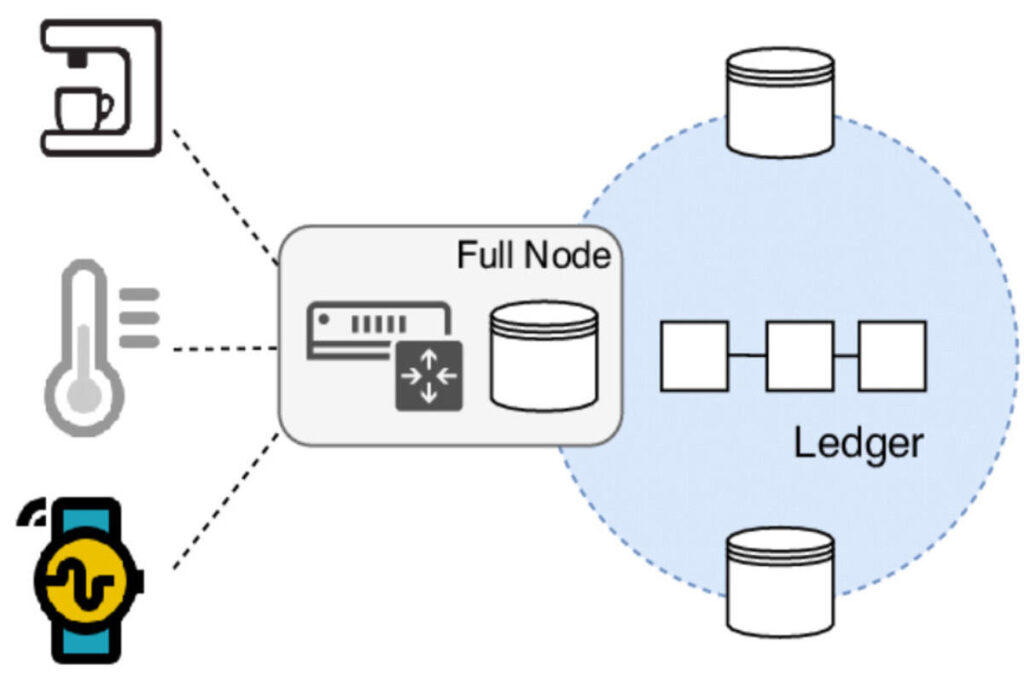With blockchain technology adoption, the economic sector is seen expanding swiftly and gaining significance. Numerous sectors such as financial services, entertainment, and supply chain management have found use for blockchain technology.
Blockchain nodes are projections of the network whose hardware is approved to manage the distributed ledger. Through this, they are able to serve as the single point of contact for various network functions. Some of the common types of blockchain nodes include Master nodes, Full nodes, and Miner nodes among others.
They are an essential part of the blockchain infrastructure as they are responsible for validating transactions and adding new blocks to the chain. This is because all cryptocurrency transactions are tracked via a blockchain where they achieve this through their dependence on consensus algorithms. This consensus algorithm determines the node’s characteristics i.e. its power and capabilities within the blockchain network.
What are Blockchain Nodes?
Blockchain nodes are physical devices used to store and process data on the blockchain. They are the fundamental elements of any decentralized ledger. This makes them have the main responsibility of verifying the legitimacy of each new block of network transactions.
🧵 What are blockchain nodes and why are they important?
1- A blockchain node is a computer or server that stores a copy of the blockchain and participates in its maintenance and validation.
— ΛBBΛƧ – ΛWΛ〽️ (@NFTMillionaire) January 3, 2023How do Nodes in the Blockchain Operate?
First, the transaction data is captured, stored, and encoded into blocks. These blocks are constantly connected to one another for them to function. Then the submitted transactions are broadcast to every network node as soon as they are received. The other nodes use a consensus process to verify the validity of block transactions. Later, after consensus is reached, the transaction block is permanently stored in the blockchain
Nodes’s Purposes
Data Processing
In the case of data processing, they handle traffic processing and management on certain nodes like gateways. They also process and manipulate data in various ways and offer services such as web hosting and file storage.
Routing
Routing in any network is the process of choosing a path. It involves forwarding requests that are recognized by a Uniform Resource Locator to the application that handles their response. For the transmission of data, Blockchain Nodes select the transmission paths. They choose a router network that enables data to be routed between devices. This guarantees that the information will get where it is supposed to.
Maintaining the Blockchain
Nodes support the blockchain networks where they create an interconnected network of data and store a local copy of the blockchain. Due to their decentralized blockchain, they benefit from not being vulnerable to attacks and sources of failure. Although the decentralized ledgers eliminate the need for a single server for data storage, as additional blocks are added to the chain, the blockchain network continues to expand quickly.
For more understanding of what decentralization storage is and its importance, follow this guide
Security
Nodes achieve this by safeguarding networks by keeping an eye on and controlling all incoming and outgoing network traffic. Because of their decentralized nature, blockchains are particularly well-suited for applications that require higher levels of security and transparency.
In this considerable guide, we will dig into the world of blockchain nodes. Let’s examine the ten types of nodes that power blockchain networks and unravel the intricate mechanisms by which they operate.
Types of Blockchain Nodes
Full Nodes

They are often referred to as fully validating nodes since they form the core of a blockchain network. These nodes keep the exact duplicate of the entire blockchain ledger ever made from the first to the last block. They are necessary for many consensus models including both Proof of Stake and Proof of Work.
Full nodes are responsible for validating transactions and blocks. They achieve this by independently checking their consistency with the network protocols. They also engage in the blockchain network consensus mechanism thus, helping them determine the sequence and legitimacy of transactions.
They prevent any party from having control over the ledger thus maintaining the decentralization of the blockchain network. Full nodes also have the ability to retrieve the previous transaction data. This makes it advantageous to the auditors, researchers, and engineers who may require access to the complete history of the blockchain.
Miner Nodes
Miner nodes verify transactions before being added to new blocks. They help guarantee that the transactions comply with network guidelines and are suitable for blockchain inclusion. Also, some Proof of work consensus models like one used by Bitcoin require miner nodes which are blockchain crucial parts.
Miner Nodes solves this by challenging mathematical puzzles in order to approve transactions on the blockchain. All these issues require a lot of electricity and very sophisticated computing equipment.
Once these Blockchain nodes complete the problem-solving process, they get paid with some freshly created tokens. Their PoW network provision contributes to network security. This is by them securing their tokens thus providing their dedication to the security of the system
A big picture of how a blockchain's components work together 🟪 ⛓
Let's count how many definitions we know in this infographic 😉#Stably #blockchain #education #block #node #confirmation #ledger #reward #miner #POW #transaction pic.twitter.com/HDekEOMnLj
— Stably (@Stably_Official) November 6, 2020Pruned Full Nodes
Pruned nodes download the whole blockchain to their hard drive before erasing the previous data. These Blockchain nodes set aside room for storing blocks of data on the hard drive. Their main advantage is that they consume less storage space compared to the full nodes. This makes them more suitable for users with limited storage capacity.
They ensure data integrity and separate validation of transactions. This is by their participation in network propagation thus contributing to data distribution. By doing this, it helps them maintain a robust network. They also access and retrieve data to their pruned block.
Light Nodes
This is the second-most common type of blockchain node. Its main purpose involves accommodating faster transactions and daily activities hence the name Simplified Payment Verification(SPV) nodes.
They are designed in a way that enables them to only store necessary information i.e. block headers. They are ideal for users who would wish to access the blockchain without having to invest time. The reason is that they can quickly integrate with the network by downloading block headers.
Archival Full Nodes
Archival Full nodes store and maintain their entire blockchain database. They have no defined storage limit thus making them the most common type of blockchain node. They store their complete history of blockchain including all transactions and historical data.
This historical data storage provides researchers and developers with access to large amounts of data needed for their analysis and auditing. They are also used for specific applications since they require a large amount of computational capacity to operate.
Archival Full Nodes are a vital resource for developers of decentralized applications(dApps). This is because they obtain and furnish past data on smart contracts.
For more understanding of what dApps are, this article got you covered
Master Nodes
This is a type of full node that validates transactions and maintains blockchain records. They are specialized in some blockchain networks, especially in projects with a privacy and governance focus. Master nodes also carry out a variety of other tasks like coin mixing and network proposal voting.
They are also crucial components of network governance since they participate in the decision-making process for network enhancements. This is by verifying submitted blocks and executing other protocol-defined managing and regulatory functions.
Developers in Master Nodes are compensated for their services with incentives. This is done in the form of transaction fees or a portion of block rewards.
To really understand the skills needed as a developer, read this article
Staking Nodes
Staking nodes authenticate themselves by using a technique called “staking”. This is achieved by stakes locking up a certain amount of cryptocurrency as collateral. They do this by creating blocs, validating transactions, and securing the network.
A staking node may comprise one user or a pool. A pool is a collection of users who pool their cryptocurrency holdings in order to increase the likelihood of being chosen to confirm blocks. It might comprise a single user or several.
Staking nodes also take part in the PoS or DPoS consensus process. The quantity of cryptocurrency they have staked determines how much of a vote they are entitled to. They also work to mine nodes in Proof of Work networks by validating transactions and generating new blocks.
Lightning Nodes
Lightning Nodes use independent network connections to carry out transactions off-chain. Thus, enabling the reduction of network congestion. For people who wish to be added to the blockchain together, they are linked by Light nodes. This helps lessen the network strain and decrease transfer times thus raising the usefulness of cryptocurrency.
Lightning Nodes works by opening a separate payment channel between entities. This is where instead of waiting for each transaction to be confirmed, parties can interact with each other and lower the load on the blockchain.
Additionally, in the event that another party wishes to transact with the same party, the lightning network will find a way thus minimizing the amount of middlemen and cutting down on wait times.
Super Nodes
Super Nodes are instantaneously generated to carry out specific functions, such as managing protocols or executing modifications to existing ones. They act as crucial hubs for user interaction and are visible and available to all users on the network.
With their improved communication, they facilitate the faster relaying of blocks and transactions across various network nodes. Super Nodes also assist in distributing network load so that it stays responsive and uniformly dispersed. They are also components of scalability solutions in various blockchains such as Bitcoin Lightning Network.
Authority Nodes
Authority nodes also known as validators nodes or consensus nodes are a particular class of specialized blockchain nodes. Authority nodes function differently from regular nodes when it comes to verifying transactions and preserving network security. The common consensus mechanism employed when adding new blocks to the blockchain includes Delegated Proof of Stake(DPoS) among others.
Conclusion
The Blockchain nodes are the backbone of decentralized networks hence they are essential for maintaining network functionality, security, and validity. They handle a broad range of use cases such as voting systems, cryptocurrency, and supply chain management. This makes them reflect the needs and objectives of various blockchain networks. To fully utilize blockchain technology in this increasingly decentralized society, it is of vital importance to take advantage of the unique strengths of various types of Blockchain nodes.



















